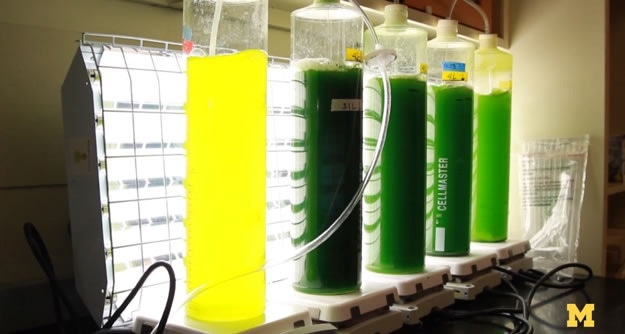Increased fuel consumption and fuel costs, and depletion of traditional sources of fuel have made researchers work on alternative forms of fuels in the last decade. Many of these research works are funded by the government, as countries are trying to become fuel-self-sufficient in the future.
Algae fuel or 'biofuel' is an alternative to fossil fuel such as coal, which uses algae as its source of natural deposits. Plenty of research has proved that oil can be extracted from algae. However, to use algae as a biofuel is definitely not as simple as collecting algae from water bodies and using it in gas tanks.
Scientists have derived various mechanical and chemical methods or combinations of methods to extract oil from algae and convert it into viable fuel. However, large-scale algaculture and marketing of algae as a major commodity is still in its infancy.
Algae farming or 'algaculture' is being commercially researched for making numerous biofuels such as vegetable oil, biodiesel, biogasoline, biomethanol, bioethanol, biobutanol on lands that are not arable.
Characteristics of Algae
Algae are tiny, plantlike organisms that grow naturally in every river, pond, lake, and reservoir on the earth’s surface. Algae are composed of carbohydrates, proteins and plant oil. The commonly used algae in biofuel production are freshwater algae such as prokaryotic and eukaryotic species. For optimum growth, algae require nutrients, sunlight and water. Algae are known to thrive on saline, brackish and waste waters as well.
The carbohydrate content in algae can be fermented to form bioethanol and biobutanol.
Algae residue is still usable as animal feedstock or as soil fertilizer.
Manufacturing Algae Fuel
The common method of manufacturing algae fuel is by using a mechanical extraction process called expression, where the algae are pressed to extract oil. Screw, expeller and piston configurations are some of the types of presses used for this process; however, this depends upon the algae strain. The extraction process can be continued if required using a chemical method. Studies reveal that 80% of the algae's oil can be procured using this method.
Another method of manufacturing algae fuel is by using a mechanical extraction process called ultrasonic method, where ultrasonic waves create bubbles in a solvent. The bubbles break open near the cell walls of the algae, causing the cell walls to break down and release the oil into the solvent. The ultrasonic method is a faster process than pressing.
In some cases, researchers have used various chemicals as solvents. These have been proven to be effective in the extraction of oil, but can be expensive and dangerous depending upon the chemical. For example, benzene as a solvent is inexpensive but labeled as carcinogenic. Hexane is sometimes added as a solvent during the pressing process to separate the oil from the algae. Studies reveal that this method extracts nearly 95% of algae's oil content.
Another chemical method is the soxhlet extraction, where an organic solvent is used to remove the oil from the algae via repeated washing. The oil extracted using this method is termed as "green crude" as its still in a raw state and cannot be directly used as fuel. This raw oil has to undergo another process called transesterification, where more substances are added to it. The substances are alcohol and a chemical catalyst to make the alcohol react with the oil. This reaction creates a mix of biodiesel and glycerol. The last step requires the glycerol to be separated from the mixture to leave behind a biodiesel that is ready to be used as a fuel.

Image Credit: Chemical Engineering, University of Michigan
Benefits of Algae Fuels
The key benefits of algae and algae fuels are listed below:
- Algae fuels would help reduce the world’s dependence on petroleum fuels
- Harvested algae release CO2 when burnt, but it is absorbed from the air by the new growing algae, which is not the case with fossil fuels
- Harvesting of algae has less impact on fresh water resources
- Algae indirectly assist the ecosystem by removing nitrogen, phosphorus, and other contaminants from wastewater
- The scientific principles of ecology provide guidance for designing and operating of large-scale algal biofuel production facilities in a successful manner
- Ocean water and even waste water can be used for growing algae
- Algae fuels are biodegradable, and non-toxic as they contain no sulfur
- Biofuel spills are comparatively harmless to the environment
- Although very expensive to grow, the fuel yield is 10 to 100 times more per unit area than other second-generation biofuel crops such as rapeseed and palms
- Algal cells have rapid growth rates, doubling one to three times per day
Summary
Algae are grown using two systems, namely, the closed systems and the open systems.
The closed systems use photobioreactors, which are clear containers that allow cultivators to monitor the species and the environment closely. So far these have been very expensive to build. The open systems grow algae in ponds, raceways, or even in the wild, thus making it less expensive to build but highly susceptible to attacks from insects, being overpowered by other species, and environmental changes.
Growing algae in a large-scale and cost-effective manner and extracting oil from these algae is a challenge that needs a practical solution if this alternative fuel is to make any major global impact.
Turning algae into fuel
Turning algae into fuel. Run Time - 2:46 mins.
Sources